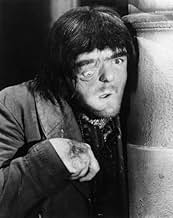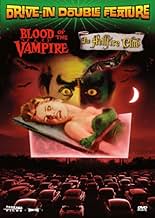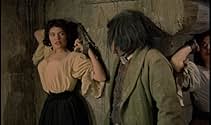Ajouter une intrigue dans votre langueIn 1870s Transylvania, scientist Dr. Callistratus is put to death by villagers who wrongly believe he's a vampire. However, his horribly disfigured henchman, Carl is on hand to orchestrate a... Tout lireIn 1870s Transylvania, scientist Dr. Callistratus is put to death by villagers who wrongly believe he's a vampire. However, his horribly disfigured henchman, Carl is on hand to orchestrate a life-saving heart transplant.In 1870s Transylvania, scientist Dr. Callistratus is put to death by villagers who wrongly believe he's a vampire. However, his horribly disfigured henchman, Carl is on hand to orchestrate a life-saving heart transplant.
- Réalisation
- Scénario
- Casting principal
- Auron
- (as Bryan Coleman/Brian Coleman)
- Third Guard
- (as Bruce Whiteman)
- Professor Meinster
- (as Henry Vidon)
Avis à la une
It is too bad that this film has been so neglected that it cannot be seen except on worn-out and ridiculously expensive factory VHS tapes that are rare, or on DVD duplicates made off of faded 16mm film prints. I saw this 30 years ago on TV from a good 35mm print and remember that the colors were great, but the recent 16mm dupe I saw was really faded. Still, increase the TV color saturation, and it's way better than nothing at all. (UPDATE: I thought I'd better update this now that a factory DVD has been recently released. No longer do you have to pay way too much to see this.)
The few occasional lapses in logic notwithstanding, this is bound to please any fan of the early Hammer horror films, and Donald Wolfit does a great turn as the doctor who has become a sort of living vampire. Though there are no real supernatural elements, this film tops many others without having to rely upon the fantastic to carry it. A fabulous beginning title sequence is followed by a great scene where the vampire-doctor is revived, with his misshapen servant beside him, and then a large bat flies out from the ceiling rafters. You would swear it was an actual bat, and then wonder how did they get it to do it just right?
As an example of the attention to detail you'll see here: during a conversation between two prisoners, a rat scurries behind one unnoticed and for no other reason than to show that the place is a squalid jail cell. Nobody sees it, yells or stomps on it, or anything you'd expect to happen in another film. It's just there and passes by. Now that's real set design!
Much of the film is set in an asylum for the criminal insane, presided over by sinister doctor Callistratus (played by renowned theatre actor Donald Wolfit, who looks uncannily like a bigger version of Bela Lugosi here). Vincent Ball is the dashing hero thrown into the chaos, finding himself at the mercy of brutal guards, vicious Dobermans lurking outside the asylum, atrocious conditions, torture, and a creepy hunchback (the sympathetic Victor Maddern, hidden beneath some delightfully grotesque makeup that puts his eye halfway down his cheek). Before long, the utterly beautiful Barbara Shelley is also on the scene and at the mercy of the villains...
Sangster's script reads like a half-baked version of THE REVENGE OF FRANKENSTEIN, and indeed he took many of the themes in this movie and strengthened them for the Hammer sequel. Still, even if the script is slightly sub-par, the pacing is spot on and there's never a boring spot here. The Gothic feel is spot on, with plenty of spooky atmosphere punctuated by sudden moments of the grotesque – a heart beating on its on in a tank, a limbless body kept alive, a corpse in a block of ice. I didn't even mind the lack of undead, as I've always enjoyed the scientific paraphernalia in these movies. Other moments of interest include brief appearances from John Le Mesurier as a judge and Bernard Bresslaw as a thief. The sole aim of this film may have been to rip-off Hammer and director Henry Cass may be workmanlike at best, but still I enjoyed this fun and colourful little romp.
Le saviez-vous
- AnecdotesVictor Maddern got a headache from the extensive makeup he had to wear as the deformed hunchback Carl.
- GaffesKurt Urach's date of death is given as 1881 in the paper, but 1892 on his tombstone.
- Citations
Callistratus: Since you're so interested in my work, there s no reason why you should not assist me. My experiments so far have been confined to male blood groups. I think it's time to extend my activity.
- Crédits fousOpening credits prologue: Transylvania 1874
The most loathsome scourge ever to afflict this earth was that of the Vampire.
Nourishing itself on warm living blood, the only known method of ending a vampire's reign of terror was to drive a wooden stake through his heart.
- Versions alternativesThere is additional footage of Karl tormenting some chained female victims and also more of his death and some bloody lab shots in a version released on VHS in France in the 80s.
- ConnexionsFeatured in 100 Years of Horror: Scream Queens (1996)
Meilleurs choix
- How long is Blood of the Vampire?Alimenté par Alexa
Détails
- Date de sortie
- Pays d’origine
- Langue
- Aussi connu sous le nom de
- Blood of the Vampire
- Lieux de tournage
- Alliance Film Studios, St Margarets, Twickenham, Middlesex, Angleterre, Royaume-Uni(studio: made at Alliance Film Studios Twickenham)
- Société de production
- Voir plus de crédits d'entreprise sur IMDbPro
- Durée
- 1h 27min(87 min)
- Rapport de forme
- 1.85 : 1

































